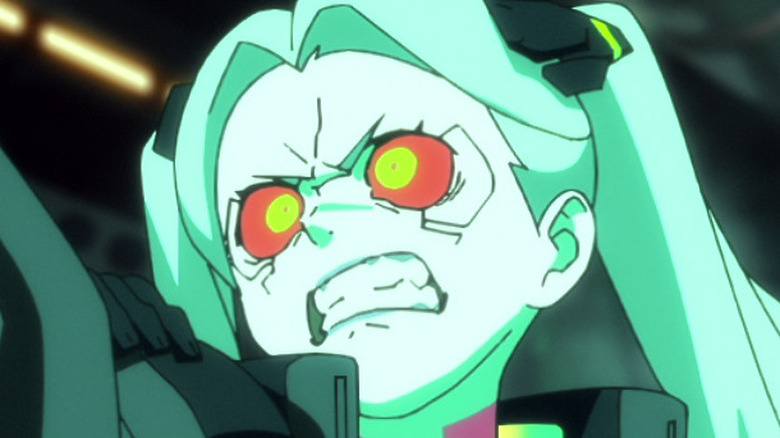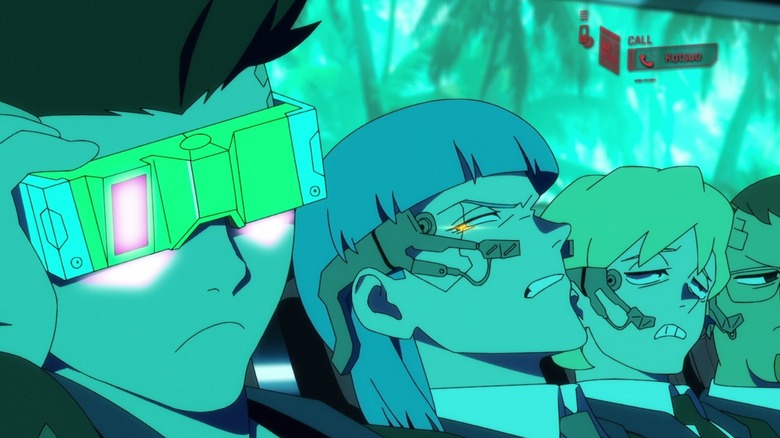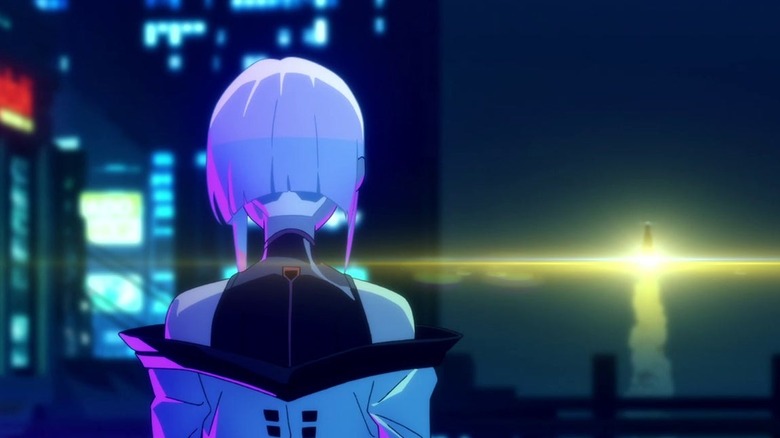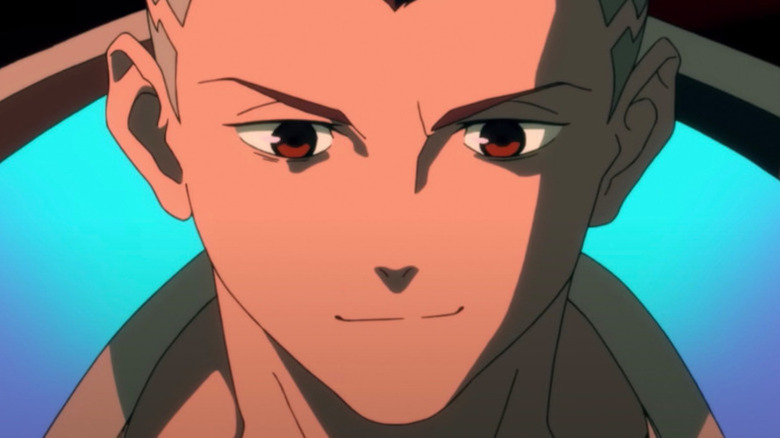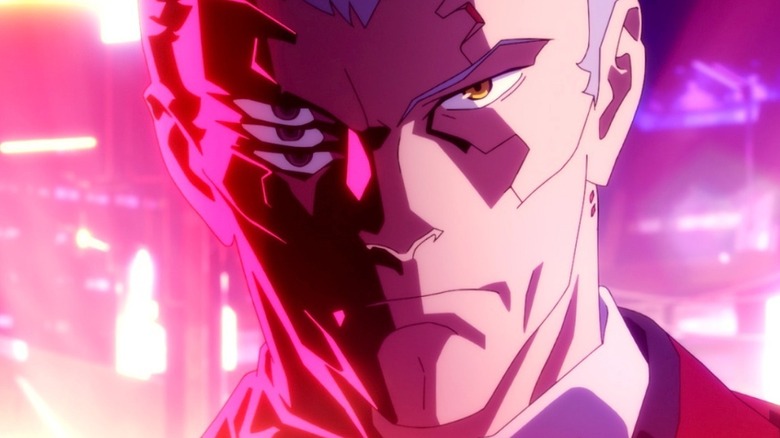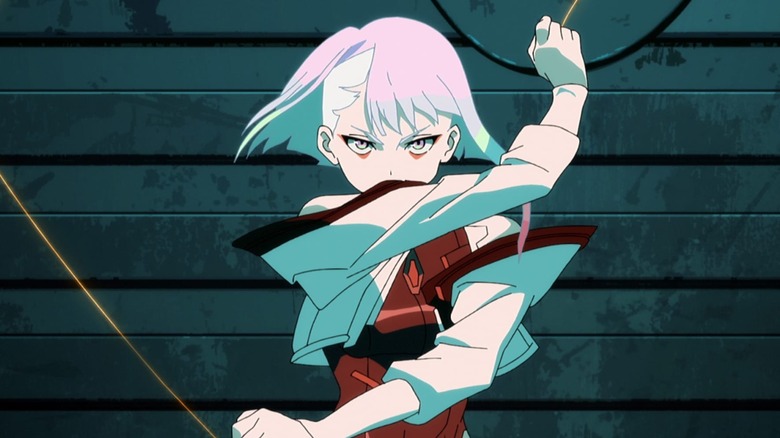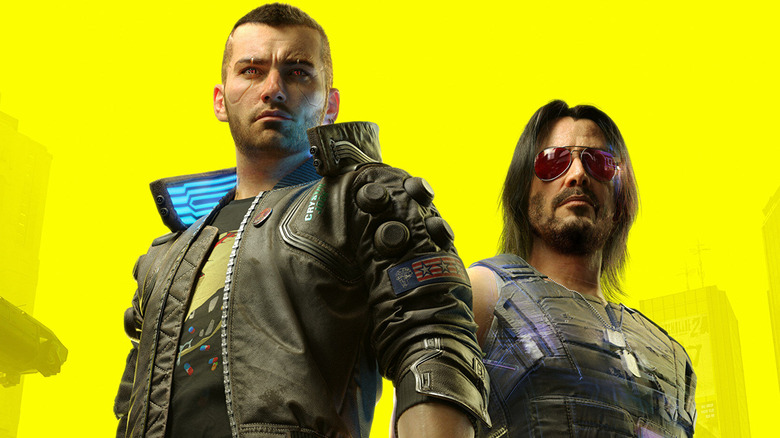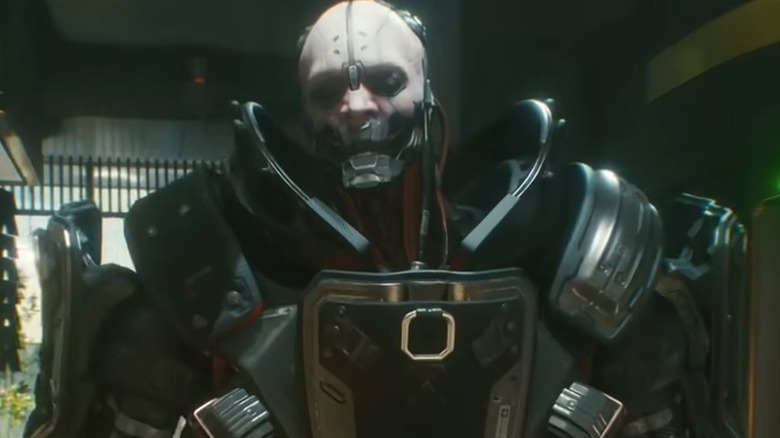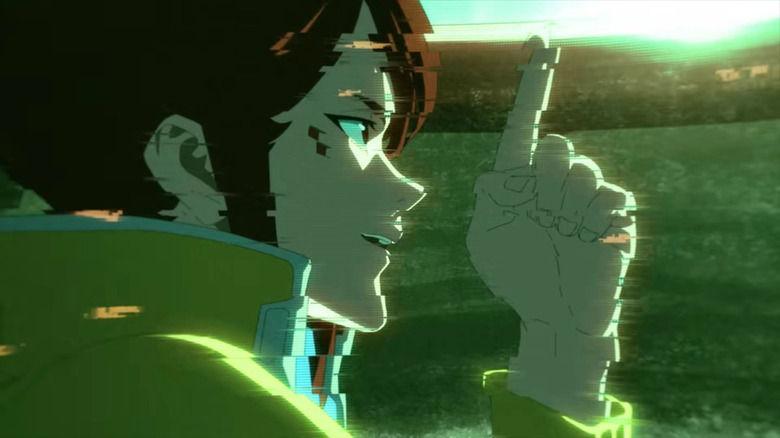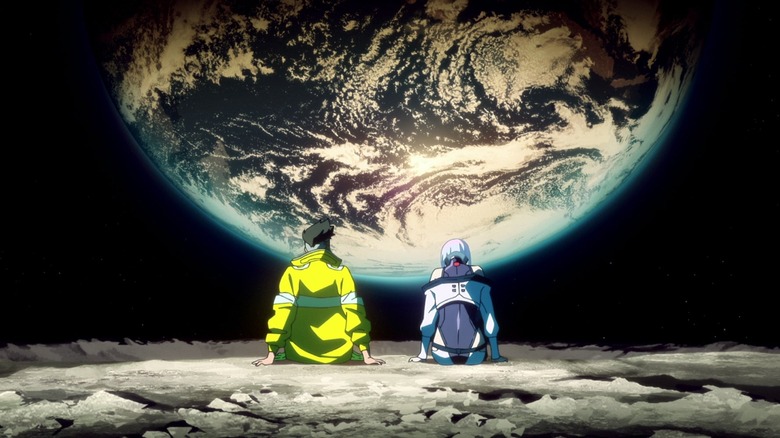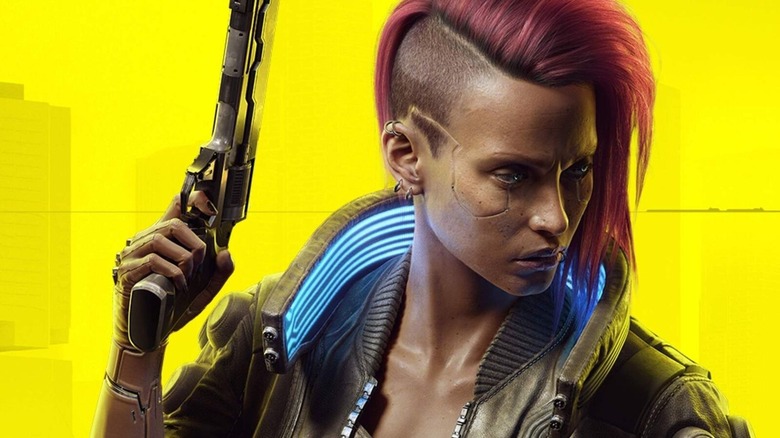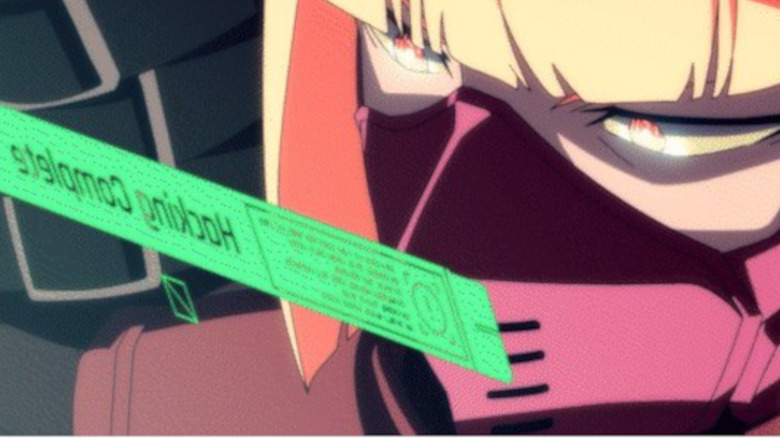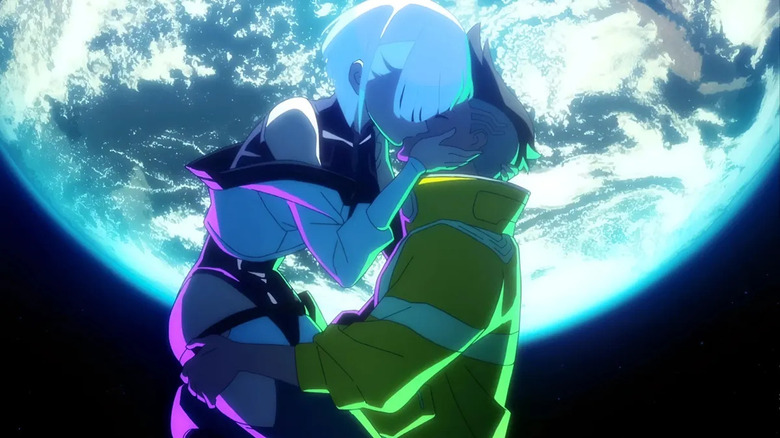Small Details You Missed In Cyberpunk: Edgerunners
The video game "Cyberpunk 2077" was a mixed hit when it debuted in 2020. Although it was plagued by bugs and glitches at first, critics became kinder after numerous updates and reappraisals. Ultimately, "Cyberpunk 2077" managed to bounce back; the game has apparently sold more than 20 million copies across all platforms as of September of 2022.
When this anime drama spinoff was announced, it was hotly anticipated, and the success of "Cyberpunk: Edgerunners" speaks for itself. Naturally, a lot of that success is due to the still-burning interest in the game and Netflix's considerable advertising and marketing blitz, but the positive word of mouth certainly didn't hurt. Just like "Arcane: League of Legends," "Edgerunners" shows how a spinoff can build on an existing world in ways that aren't just exciting, but recontextualize the source material altogether.
The worldbuilding of "Edgerunners" might be its most significant element, and we'll certainly talk about it here. But here's one bonus factoid before we start – Street Kid is the lifepath choice of most gamers, and the show's knowing revisitation of that lifepath both references the experience of playing "Cyberpunk 2077" and establishes the groundwork for a story that could only be told serially over the long term.
Did you love "Cyberpunk: Edgerunners" as much as the critics? How well do you know it? In this article we'll look at some stuff you might have missed that adds a whole other level to this brilliant work.
Everything's a subscription
Perhaps the most realistic of all the futurist touches in "Cyberpunk: Edgerunners" is the fact that seemingly everything in the world of the show is a subscription service. Early in the series, we see David watching his school uniform in the washing machine, which stops when his family reaches its wash limit. What this implies is that the machine itself was probably a loss leader meant to lock people into a subscription to be able to use it.
We see similar patterns unfold throughout the show, particularly in the trauma team medical coverage, as well as various utilities. The former especially is a dystopian touch — several times in the show, it's made clear that even the basic medical care that's available to you is based on your subscription payments. Basically, the healthcare system in Night City is a slightly exaggerated version of how medical coverage works in modern-day America, but it plays an important part in the story — it's Gloria's cut-rate medical coverage that leads to big changes in David's life and ultimately puts him on a path to destruction.
Corpo, Nomad, or Street Kid?
In the stratified world of "Cyberpunk 2077," you are given three choices to play your role. You can be a "Corpo," or a corporate creature raised in the upper echelons; you can be a "Street Kid" from down below, or you can be a "Nomad" born outside the city. In all three cases, where you are born virtually writes your future prospects in stone.
"Cyberpunk: Edgerunners" is intriguing in that we get to see not one, but two of these types during a character's youth. First, we see David attempting social mobility and becoming a Corpo attending his upper-crust academy; once he's on his own, we see him living out his Street Kid destiny. This is no surprise, considering Street Kid is far and away the most popular player character role and naturally has the most cyberpunk qualities. Still, getting to see Corpos as children and watching David grow up on the streets answers many of the questions we still had after playing the game.
Lingo of Night City
Part of what makes "Cyberpunk" and its worldbuilding so exciting is the way we're thrown into the deep end. For instance, we have to decipher some of this future vernacular based solely on context.
Some terms like "Ripperdoc" and "cyberpsycho" meet the needs of the narrative itself. A story about implants and medical transformation needs someone to administer those things, and the term "Ripperdoc" gives this role a cyberpunk sheen of oil and dirt. "Cyberpsychosis" and "cyberpsycho" are, of course, major parts of David's story.
"Picksocket" and "gangoon" are two more terms that come straight out of the narrative. A "picksocket" is someone who pickpockets people's chrome slots, or sockets, to take their shards and other kinds of chips for resale. A "gangoon" is a goon who is a member of a gang, of course, but the neologism also gives the term an international feel.
More casually dropped terms include "choom," or friend; "gonk," or fool; "klep," or to steal; "delta," to move; "scroll" to watch a feed, and "Eddies" (Eurodollars, the currency in use). The remainder of notable created words mostly shorten terms we already use: pleb(ian), preem(ium), (super)nova, circ(uit), (or)ganic, strat(egy), sig(nal), and coord(inate)s are a few examples.
Gangs of Night City
The Tyger Claws are the group we see the most in "Edgerunners," as they're funded by Arasaka and do a lot of the corporation's dirty work. The chrome-addicted Maelstrom are among the most powerful gangs in the game, and some cyberpsychos seem to come from their ranks. The 6th Street of Santo Domingo group is known for their military style, and for taking territory from the Night City PD. It's possible this is the gang up against the Bozos in a car chase that ultimately ends Gloria's life.
The Scavengers are much-discussed Night City boogeymen who take implants by force off anyone they meet so they can sell them. The Animals mainly work as bouncers and bodyguards in the game, and we see them in this capacity in the show as well. The Aldecaldos are the Nomad group Panam Palmer comes from in the game, and the Wraiths also live in the Badlands. We don't spend a lot of time outside Night City for much of the season, but many of the locations we see are familiar.
Other gangs mentioned briefly, or we hope we see in future seasons, include the sex-positive guardian angels known as the Mox, the community-minded Valentinos, and the netrunning hackers of the Voodoo Boys.
Literary references
A subset of science fiction, literary cyberpunk combines a futuristic, neon-lit aesthetic with stories of a global monoculture enabled by the Internet. It's a look and genre that the "Cyberpunk" game and show both revel in.
In William Gibson's "Neuromancer" — one of the earlier definitive works of cyberpunk fiction — most of the narrative is focused on a netrunner named Case who contributes military muscle to a heist quite like those we see multiple times in both "Cyberpunk 2077" and "Edgerunners." "Neuromancer" was followed by "Count Zero," which includes characters following what we might call the "Nomad" lifepath — dusty roads, clanking machinery, mysterious goals, and dreaming hackers all combine to bring a new kind of interface to the internet. Just as in "Cyberpunk," the older version of the internet has split into lots of little localities — just the kind of mess that Lucy was raised to investigate.
Three books in all make up Gibson's "Sprawl" sequence, which also notably introduce Molly Millions, aka Sally Shears, a beloved merc with skills for days who clearly helped inspire Lucy and Kiwi in the show.
Other references in the show include some nods to the narrative of cyberpunk classic "Akira," as well as the henchman Deckard sharing his name with the protagonist of 1982's classic film "Blade Runner," based loosely on Philip K. Dick's "Do Androids Dream of Electric Sheep?"
References to Cyberpunk 2077
The tight crossover between media means "Cyberpunk" gamers have an advantage when it comes to picking out references to the game that might otherwise make no sense at all. Lists of these connections, Easter eggs, and in-jokes can be found all over the web.
For instance, in the episode "Lucky You," we see David attempt to drive for the first time — a mess that, for gamers, might trigger flashbacks to driving in "Cyberpunk 2077." The game doesn't train you to drive, but nevertheless sometimes requires you to do so. As David gains in skill, we see fewer fender-benders.
In the episode "Stay," Rebecca and David interrupt a crime in progress; that's another classic in-game situation, down to the street setting and blockades that signify the crime. We see a few other notable settings; David's second apartment seems modeled on one of the most important homes in the game, and there are a couple of fights in the show that should feel very familiar to gamers.
Wakako Okada also makes a cameo as a fixer who gives you assignments during your mid-career rise as V — just like she does at the same point in David's career.
Adam Smasher
Adam Smasher was a legend within the game's lore even back in 1988 when it started as a tabletop game. Maybe that's why his introduction in "Cyberpunk 2077" seems so overblown. The way everyone acts about Adam Smasher in the game — which is to treat him almost as an urban legend — is explained by the fact that he killed Johnny Silverhand, setting the game's story in motion in many ways. As Arasaka's in-house superhuman, you hear a lot more about Adam Smasher than you interact with him.
In the show, there's no mention of Johnny Silverhand, but Adam Smasher is still talked about in hushed tones. When he finally appears, it's as a foil to David in his new cyberskeleton, and the two superhumans face off. Adam Smasher is the logical endpoint for David's journey, as he is the only other person "special" enough to resist cyberpsychosis (for a while, anyway) and take on as much chrome as these two men eventually do.
Including Adam Smasher and building out an entire storyline around him — which we could say "Edgerunners" does by creating a protagonist who's a worthy adversary and spiritual double — is a beautiful way to honor not just "Cyberpunk 2077" but the games that came before it.
Gloria's presence
One key character lost too early is David's mother Gloria Martinez. Her death contributes to the worldbuilding not just by showing the consequences of Night City's overwhelming crime problem and the callousness of the trauma team that leaves her to die, but the absurd horror of the for-profit medical system.
Gloria is the architect of David's attendance at Arasaka Academy, which is intended to move him from a Street Kid to a Corpo lifepath — she even smuggles weapons to pay for it. Therefore, David feels he is letting her down no matter how high he rises in Night City's underworld. Later, David compares her to Maine, Gloria's friend who becomes a sort of surrogate father, and says they both had "plans" for him. It's interesting that one plan involved him changing paths altogether, whereas Maine just wants to see David thrive on the streets.
What you might not notice here, however, is the numerous shots of Gloria's ashes that remind us of this plan and David's grief. The canister appears in the episode "Stay" muddled among David's art supplies, showing how he is moving past his grief by dedicating himself to Maine's group. Later, we flash on the canister just as David is making his choice to risk cyberpsychosis, reminding us that nobody in David's life wants it to end that way.
To the moon
When we meet David, he's heading off to school in a montage that takes him from the literal garbage to his tony prep school across the city. On mass transit, he sees a shuttle blasting off into space. And though we haven't met Lucy yet, or uncovered all the layered meanings under the shuttle launches, it's still the first symbolic instance of a major motif in the story: The moon itself.
In "Cyberpunk: Edgerunners," the moon is a symbol of freedom from the torturous hustle David and Lucy both feel locked into. Visiting or moving to the moon begins as Lucy's dream; the moon is a quiet, peaceful place that's the exact opposite of Night City where you're free to move and the horizon is not so far away. But travel to the moon is prohibitively expensive, so it must remain a dream — thus symbolizing the improbability of ever escaping this life.
Over the course of the story, the moon motif expands to include David. First, Lucy lets him in on her secrets by showing him the sophisticated moon VR where he feels the sun on his face, and they stare up at the Earth. Later, she saves his life and mind by kissing him, which takes place in front of the moon. And finally, once all is said and done, Lucy honors David by going to the moon in person to remember him.
V's journey
In the episode "All Eyez On Me," David is told that his addiction to chrome (implants) is leading him to a point of no return — "Lose yourself forever or die, no in-between," as the show puts it. This is a strong reference to the game's narrative, in which the protagonist V shares their body with Johnny Silverhand's spirit in such a way that threatens their life — "Lose yourself forever or die" is the game's first and final invitation.
As game director Adam Badowski told Polygon, "This is cyberpunk, so people augment their body... the body is no longer sacrum [sacred]; it's profanum [profane]. Because people modify everything, they are losing their connection to the body, to the meat."
In this way, the show recapitulates V's journey in a new form. Whereas V is up against a ticking clock due to no fault of their own, David's own movement toward this point of no return is completely self-motivated. While at each juncture David feels it's necessary to overuse his powers and-slash-or enhance them with more and more chrome, an objective bystander might disagree. The end result is the same, however — Lose yourself, whether it's to the chrome or to Johnny, or physically die anyway.
The clues are all there
Cyberpunk as a genre tends to draw strongly on film noir tropes, and that goes double for "Cyberpunk: Edgerunners." We're told again and again to trust no one — even Lucy is sometimes suspect — but when the inevitable betrayal eventually occurs, it's shocking to everyone involved. But the clues were there all along, if David could just see them.
Kiwi not only warns Lucy multiple times about trust, she covers her face with a mask — a kind of shorthand for her secrets. She also speaks throughout the series in doubles — "Can-can" for "can," "side-side" for "side," and so on. She is a double (or triple!) agent, so this notable quirk really sticks out.
The group's dirty fixer Faraday is voiced by Giancarlo Esposito — a huge red flag for fans of the show "Breaking Bad," where he plays a major dealer with strong ties to a Mexican drug cartel, which he eventually betrays. Faraday also has three right eyes implanted, giving him a strange look that evokes the same multiple-eye effect the show uses to demonstrate cyberpsychosis.
The music tells the story
There's nothing new about shows using music lyrics to move the story along, but "Cyberpunk: Edgerunners" makes it worth a rewatch with captions on. So many of the lyrics of the songs chosen for the show have secondary or primary meanings connected to the scene in which they play.
For example, there's the main theme, "This Fire" by Franz Ferdinand — sometimes stylized as "This Fffire" — which refers to a "fire in me" burning "out of control," and threatens to "burn this city ... burn it down." These are clear references to the story's major themes: firstly notable because of the fact that the city is barely under control at any time, but also David's journey toward cyberpsychosis. Both metaphorically and figuratively, the "fire" here refers to David's motivating force as he grows up, grows stronger, and eventually begins to take possession of his own strength which, like fire, is as destructive as it is powerful.
In "Stay," both Rebecca and Lucy try to talk to David about his encroaching cyberpsychosis. And as he gives in, we can hear a voice in the background singing "This is your destiny ... This is the sign," a clear reference to the illness from which he will eventually find no escape.
